Key figures
The average rent for new lets in the UK is £1,301 as of July 2025 (published in September 2025).
Rents have risen 2.4% in the last year, the slowest rate of growth seen in 4 years.
July 2025 | April 2025 | January 2025 | |
Average rent (new lets only) | £1,301 | £1,287 | £1,279 |
Annual rental growth | +2.4% | +2.8% | +2.7% |
Softest rental market for 5 years cools rental inflation
Rental market conditions are the weakest for 5 years. Letting agents are getting 24% fewer enquiries to rent homes than a year ago. This is the lowest level for the month of August since 2020 as migration levels fall and mortgage availability improves for first-time buyers.
The number of homes for rent is steadily rising, at almost a fifth higher than a year ago. Homes are staying on the market for slightly longer as demand cools, with a current average of 16 days to find a tenant compared to 12 days in 2023 and 20 days pre-pandemic.
More homes for rent and weaker demand has stalled the growth in rents, which are just 2.4% higher than July 2024. This is the slowest pace of rental inflation for four years (July 2021) and less than half the annual rate recorded a year ago (5.1%). The average UK rent is £1,300 a month, with rents posting small falls in some markets as weaker demand and higher supply impact rent levels.
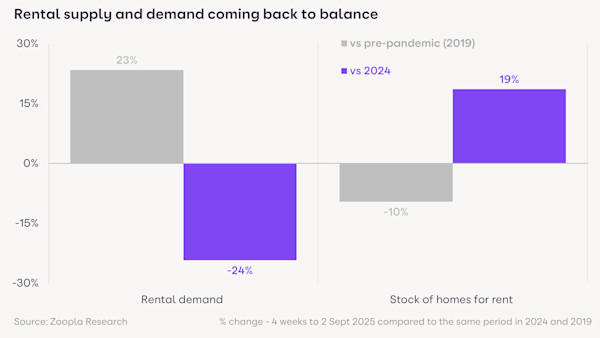
More investment by landlords boosting rental supply
The average letting agent now has 19 homes available to rent, up from a low of just 14 in 2022. Over recent years, limited supply and strong demand pushed rents 36% higher since 2020, while house prices rose by around 20%. This has lifted returns for landlords, with average rental yields at 6% across the UK and rising above 7.5% in areas such as the North East and Scotland.
With yields improving and mortgage rates stabilising, more landlords are choosing to invest again. The number of new buy-to-let mortgages for home purchases rose by 60% in the year to the first quarter of 2025, supporting the growth in rental supply.
For renters, conditions are also shifting. Easier access to mortgages is helping more people become first-time buyers, freeing up homes for rent. And with record numbers of properties now for sale (some of which may be switched to rental if they don’t sell) the choice of rental homes is likely to continue improving.
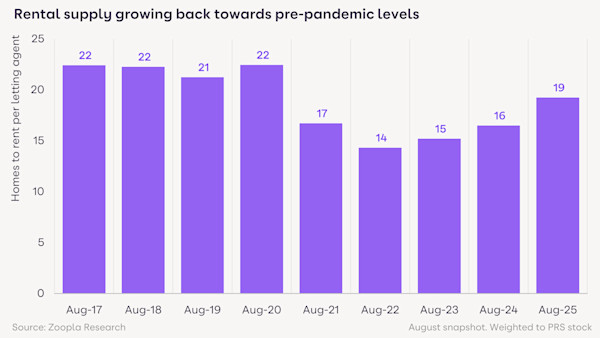
Rental supply up across all areas except London
The number of homes available to rent has increased across all regions compared to last year. Supply is up by more than a third (36%) in the South West and 31% in the East Midlands. In the South West especially, a rise in homes for sale suggests some owners may choose to let their properties if they struggle to find a buyer, adding further to rental supply. For renters, this means more choice and less upward pressure on rents for newly listed homes.
London, however, is bucking the national trend. Rental supply in the capital is just 6% higher than a year ago. Investment levels are lower, with average yields at a more modest 5%. Landlords buying with a mortgage also face far higher barriers, needing an average deposit of £187,000 compared with just £29,000 in the North East. On top of this, London has the highest proportion of landlords looking to sell (around 31% of homes for sale) which is restricting growth in the rental stock.
Rental demand weakest for 5 years
Demand for rented homes exploded over the post-pandemic years as the economy re-opened and migration into the UK for work and study grew rapidly, peaking in mid-2023. A trebling in average mortgage rates over 2022 and into 2023 hit demand in the sales market, which boosted demand further in the rental market.
Tighter visa rules have led to levels of migration almost halving over 2024, while greater stability in mortgage rates and rising incomes have boosted demand among renters to buy homes, easing some of the excess pressure on the rental market.
In Q1 2025 there were changes to the way the affordability of mortgages are assessed, which delivered a 20% boost to borrowing capacity for first-time buyers (FTBs). This explains a 30% jump in FTB mortgages over the last year, which is one reason that the demand for renting is weakening and more supply is being released.
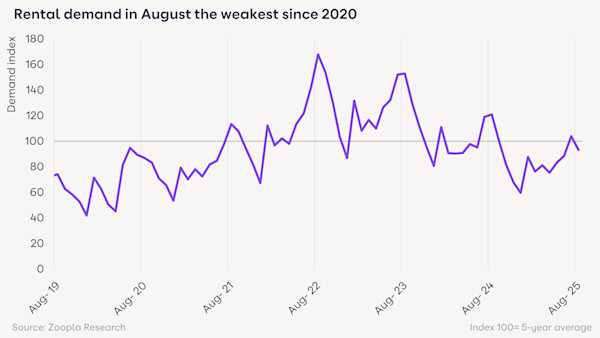
Affordability impacts demand and rental inflation
The affordability of renting is a growing challenge for renters and is holding back rental inflation. The average UK rent has increased by just under £80 a week over the last 5 years (£4,100 more a year), compounding the cost-of-living pressures on renting households.
Many private renters are on below-average household incomes. Almost a third rely on housing benefit to support rental costs, where the allowance has not kept pace with rental increases.
This means affordability is a growing constraint on renters that impacts the pace of rent inflation, which has slowed sharply across much of the country over the last year. At a regional level, annual rent inflation ranges from less than 2% in London, Scotland and Yorkshire and Humberside to 4.6% in the North East.
At a localised level, rents are falling across cities including Bristol (-0.5%) and Leeds (-0.6%). Rental inflation has also slowed across all cities compared to the typical growth rates over the last 5 years.
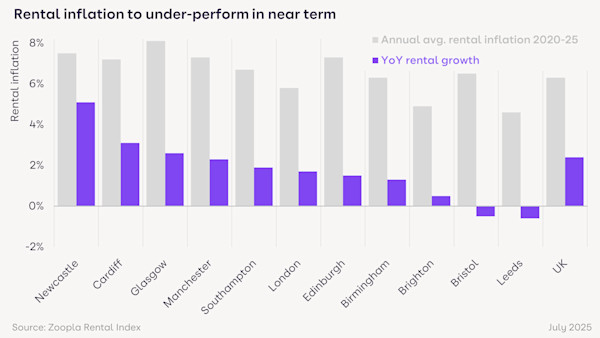
Rental market outlook
Rental market conditions are starting to normalise after a frantic few years characterised by many renters chasing too few homes as landlords held back from investing, which pushed rents higher.
Supply and demand are coming back into balance, but the unaffordability of home ownership is trapping people in private renting, which is keeping rental demand above pre-pandemic levels.
It’s positive that the number of homes for rent is steadily recovering. However, we don’t expect a surge of new investment activity by landlords to accelerate the supply of homes for rent.
Rental inflation remains on track to be 3% over 2025. Encouraging new investment and growing the supply of homes for rent is the only long-term solution to easing the pressure on renters across Britain.
Download the Zoopla Rental Market Report: September 2025
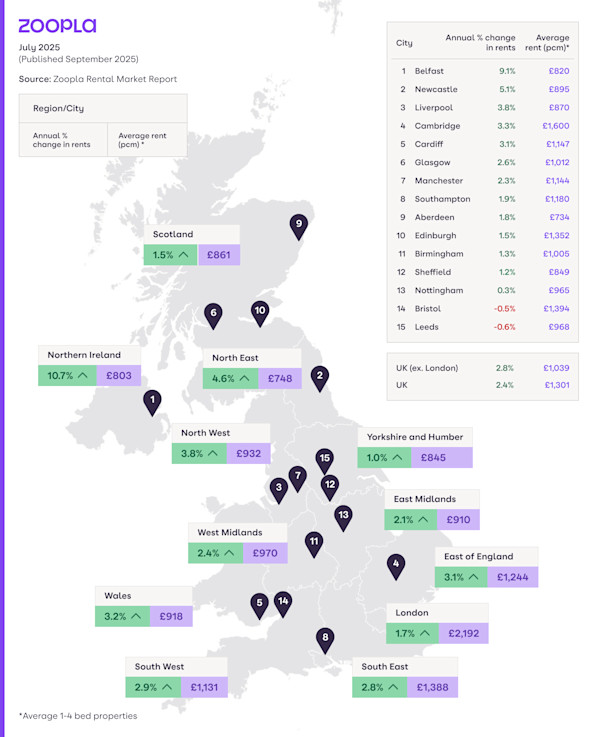
Previous Rental Market Reports
See more news from our Rental Market Report
Our Rental Market Index is a repeat transaction index, based on asking rents and adjusted to reflect achieved rents. The index is designed to accurately track the change in rental pricing for UK housing.



